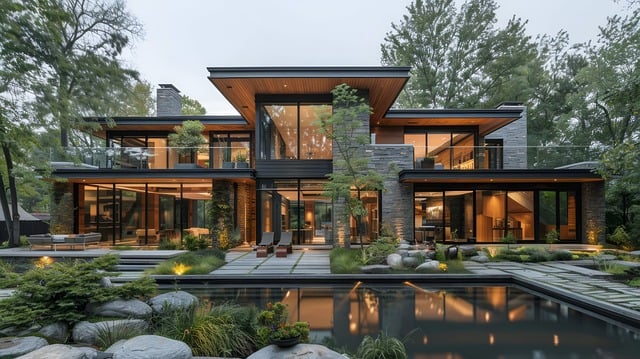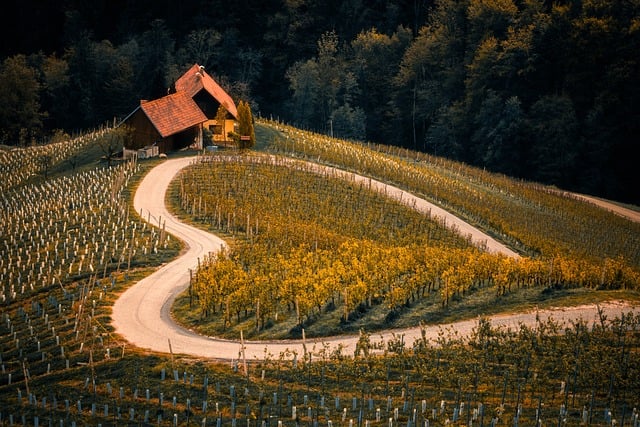Transforming an outdoor area into a serene and balanced retreat involves strategic use of symmetry or asymmetry in landscape design. Symmetrical designs, centered around a principal axis, create structured and visually appealing formal landscapes, while asymmetrical designs offer a natural and organic feel that reflects the unpredictable beauty of nature. Both approaches can make smaller spaces appear more expansive, with modern geometric shapes and clean lines complementing contemporary homes. Landscape layout ideas should consider scale and proportion for functionality, aesthetics, and personal expression. Integrating asymmetry can enhance personalization and create dynamic focal points, making every outdoor space unique and harmonious. DIY landscape planning with available online resources allows homeowners to tailor their designs to individual tastes, climatic conditions, and sizes, ensuring a bespoke outdoor environment that is both a sanctuary and an extension of the home. Whether you're into modern landscapes or small yard designs, adhering to these landscaping design tips can result in an outdoor area that stands out for its tranquility, functionality, and personal touch.
Landscaping your outdoor space can transform a simple backyard into a tranquil haven or an elegant extension of your home. This article explores the art of creating harmonious garden and landscape layouts, whether you’re aiming for structured beauty with symmetry or a natural, free-flowing design with asymmetry. We’ll guide you through mastering formal layout ideas that exude order and precision, perfect for those who appreciate the classic and timeless. For a more organic approach, we’ll delve into the principles of asymmetry to achieve a garden that feels authentic and alive. Additionally, we’ll provide landscape layout planning tips tailored for small yards, ensuring maximum impact with clever use of space. Discover modern and DIY landscape blueprint ideas designed to inspire and simplify your outdoor space planning, regardless of yard size. Elevate your garden’s aesthetic with our comprehensive guide on landscape design tips that cater to both formality and nature’s charm.
- Mastering Symmetry: Crafting Formal Landscape Layout Ideas for Structured Beauty
- Embracing Asymmetry: Organic Garden Layout Planning for a Natural Appeal
- Backyard Design Layouts: Integrating Landscaping Design Tips for Outdoor Space Planning
- Modern and DIY Landscape Blueprint Ideas for Small Yards with Maximum Impact
Mastering Symmetry: Crafting Formal Landscape Layout Ideas for Structured Beauty

When embarking on a journey to create a formal landscape, symmetry plays a pivotal role in achieving structured beauty that exudes balance and order. A well-crafted symmetrical design can transform an outdoor space into a tranquil retreat, reflecting a sense of harmony and elegance. To begin garden layout planning, consider the central axis as the foundation of your symmetrical landscape layout ideas; it will guide the placement of elements such as flower beds, pathways, and focal points, creating a clear visual line that anchors the design. Utilize landscaping design tips like repeating patterns on either side of this axis to enhance the effect of symmetry, ensuring each element has a counterpart. For instance, if you plant a row of shrubs on one side, mirror it precisely on the opposite side for a cohesive and balanced look. Incorporating a backyard design layout with symmetry can also frame views and lead the eye through the landscape, making even small yard layout ideas appear more expansive and thoughtfully designed.
Modern landscape layouts often incorporate geometric shapes and clean lines that complement contemporary architectural styles. When planning your outdoor space, think about integrating elements like rectangular water features or circular seating areas to infuse your design with a modern sensibility. DIY landscape planning is made easier with the wealth of landscape blueprint ideas available online, which can serve as inspiration for personalizing your symmetrical layout to suit your specific needs and preferences. Whether you’re working with a sprawling estate or a small yard, these resources can guide you through every step of the process, from selecting plant varieties that thrive in your climate to determining the best locations for hardscapes like patios and retaining walls. With careful consideration of scale, proportion, and balance, your symmetrical landscape will not only be aesthetically pleasing but also a functional extension of your home.
Embracing Asymmetry: Organic Garden Layout Planning for a Natural Appeal

When contemplating a garden layout that exudes natural charm and appeal, asymmetry becomes a key element in organic garden layout planning. This approach to landscape layout ideas allows for a more free-form and less structured design, which can better mimic the serendipitous beauty found in nature. By thoughtfully integrating garden layout planning that includes curves and irregular shapes, you can create a space that feels both personalized and harmonious with its surroundings. This organic style often involves a careful balance of plant forms, textures, and colors to give the impression of a landscape that has evolved over time, rather than being deliberately constructed.
Incorporating asymmetry into your backyard design layout can transform an outdoor space planning project from ordinary to extraordinary. Modern landscape layouts that embrace this principle often feature focal points that are not directly mirrored on opposite sides, thus avoiding a sense of rigidity. DIY landscape planning for small yard layout ideas can be particularly well-served by asymmetry, as it can make the most of limited spaces by drawing the eye across the garden in varied and engaging ways. The result is a backyard that feels alive and dynamic, with each element contributing to an overall sense of flow and balance that only appears effortless.
Asymmetrical designs in landscaping are not just about breaking the mold; they’re about creating a space that tells a story or reflects the owner’s personality. Landscape blueprint ideas that incorporate asymmetry can offer a canvas for creativity, allowing homeowners to experiment with different elements like water features, seating areas, and pathways in a way that feels authentic and organic. This design philosophy encourages a deeper connection with the environment, as it often involves working with existing features rather than against them. By adopting these landscaping design tips, you can ensure your outdoor space planning not only stands out but also serves as a tranquil retreat that complements the natural beauty of your property.
Backyard Design Layouts: Integrating Landscaping Design Tips for Outdoor Space Planning

When crafting a backyard design layout that exudes both functionality and visual appeal, considering landscape layout ideas is paramount. A well-thought-out plan can transform an ordinary outdoor space into an extension of your home, reflecting your personal style and needs. To begin with, integrating elements from garden layout planning principles can significantly enhance the usability and aesthetic of your backyard. Elements such as pathways, seating areas, and plant selections should be harmoniously arranged to create a cohesive and inviting environment. For those who prefer a more natural look, embracing asymmetry in your backyard design layout can lend itself to a landscape that feels organic and less structured, while still adhering to landscaping design tips that emphasize flow and balance. This approach can make small yard layout ideas seem more expansive and can be achieved through the careful placement of hardscapes, such as stone accents or garden beds, which can anchor the space without overpowering it.
For those who are embarking on DIY landscape planning, it’s beneficial to start with a clear vision. Begin by sketching out your landscape blueprint ideas, considering the spatial dynamics of your property. This step will help you visualize the arrangement of plants, structures, and outdoor elements, ensuring that every inch of your backyard is optimized for both beauty and function. Modern landscape layouts often incorporate sustainable practices and low-maintenance plant selections, which not only conserve resources but also reduce the time spent on upkeep. By researching and selecting from a wide array of garden layout planning resources, homeowners can create a bespoke outdoor space that is both a sanctuary and a showcase of their personal taste. Whether you’re an amateur or a seasoned landscaper, these landscape design tips will guide you in transforming your backyard into a tranquil oasis or a vibrant gathering spot for years to come.
Modern and DIY Landscape Blueprint Ideas for Small Yards with Maximum Impact

When designing a small yard to maximize impact, considering the balance between form and function is key. Landscape layout ideas that prioritize symmetry can create a structured and formal appearance, often seen in modern landscape layouts. These symmetrical designs can make the most of limited space by creating clear visual axes and balanced plantings, which can visually expand the yard’s perceived size. For those looking for garden layout planning that feels more organic, asymmetry is the answer. Asymmetrical backyard design layouts offer a natural and less structured look that complements the irregularity of most yards. This approach can introduce a sense of movement and flow, inviting exploration and interaction with the space.
Incorporating landscaping design tips into your outdoor space planning is essential for small yards that aim to have maximum impact. Utilizing focal points, such as a striking piece of garden art or a vibrant plant variety, can anchor the design and draw the eye. Strategic use of materials, textures, and heights within the layout can add depth and interest without the need for expansive space. DIY landscape planning allows for personalization and cost-effectiveness, with countless resources available to guide homeowners through the process. From creating a detailed landscape blueprint ideas that outlines plant placement to selecting materials that complement both the home and the natural environment, a well-thought-out plan can transform even the smallest of yards into an inviting oasis.
In conclusion, whether you’re drawn to the structured elegance of formal landscape layouts or the organic charm of asymmetry, there are myriad landscape and garden layout planning options to suit your outdoor space planning needs. For those with a penchant for symmetry and formality, mastering these principles can yield stunning, structured beauty in even the smallest yards. On the other hand, embracing asymmetry allows one to create a natural appeal that feels effortlessly integrated into its surroundings. Landscaping design tips are invaluable resources for both approaches, offering guidance on modern landscape layouts and practical DIY landscape planning techniques. By exploring these diverse strategies, anyone can transform their backyard design layout into a haven of tranquility or an exuberant expression of natural flair. With the right approach and attention to detail, your outdoor space can achieve maximum impact with minimal space, making the most of your garden’s potential.
